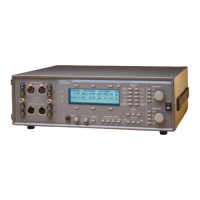Surprises and Pitfalls in THD+N Measurements
What Signal is Dominant?
While all types of unwanted sounds are included in the THD+N measurement, they
may not all contribute to the overall reading. Like all voltmeter readings on signals that
include several frequency components, the highest-amplitude components will
dominate the reading.
When comparing two individual signal components such as interference tones or
distortion products, the limit is commonly considered to be 10 dB. If one component is
10 dB above the other, only the higher component will be significant to an amplitude
reading. However, when there are many lower components, the combination may
become significant. For example, random noise can be a significant contribution to a
THD+N measurement even though its amplitude at any particular frequency is well
below other products. Since noise exists at every frequency, and each frequency has a
tiny effect on the overall reading, the combination of all the noise may be quite
significant.
Often THD+N tests will be used in conjunction with noise-only tests to be certain that a
problem is not hiding underneath a more significant contributor.
The section ‘Isolating Sources of THD+N’ (page 4-20) explains some strategies for
determining which unwanted signal is dominating the reading.
Selecting Bandwidth
Selection of a bandwidth-limiting filter is often of critical importance in THD+N
measurements. This is mainly for two reasons:
Noise exists at every frequency. The wider the bandwidth of the measurement, the
more noise is included.
Limiting the bandwidth can eliminate other components, which you may or may not
want included in the measurement.
The amount of noise included in the measurement will be directly related to the
bandwidth. If you are more concerned with distortion and interference products than
noise, it is wise to set the upper band limit to allow the highest component of interest
but reject noise above that frequency. Most mechanisms that create harmonic distortion
concentrate most of the distortion in the second and third multiples (harmonics) of the
fundamental. Therefore, for most devices it is reasonable to limit the bandwidth to
around four times the highest fundamental frequency of interest.
4 Functions
Function Descriptions THD+N (Total Harmonic Distortion plus Noise)
ATS-1 Dual Domain User's Manual 4-13

